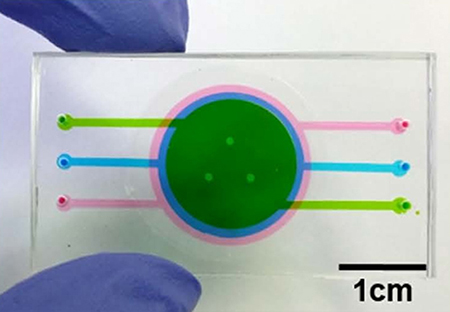Skin model developed to replace animal-clinical tests
Skin model developed to replace animal-clinical tests
- Prof. Tae Hyun Choi developed skin model microchips.
- A breakthrough in new drug development and cosmetic safety testing
 A research team led by Professor Tae Hyun Choi of the department of plastic and reconstructive surgery at Seoul National University Hospital (SNUH) and Professor Sang-hoon Lee at Korea University has successfully developed an artificial skin model that will replace an animal test.
A research team led by Professor Tae Hyun Choi of the department of plastic and reconstructive surgery at Seoul National University Hospital (SNUH) and Professor Sang-hoon Lee at Korea University has successfully developed an artificial skin model that will replace an animal test.
The skin model microchip is an artificial organ produced by growing human cells on 1 cm-sized silicone. It is manufactured in the same way as with semiconductors and called an 'organ on a chip.'
Clinical trials for animals and humans are essential to determine the toxicity and safety of newly developed cosmetics as well as drugs. In Europe, an animal (in vivo) tests for cosmetic products has been completely banned since 2013, but the demand for an in vitro tests is on the rise. The newly developed organ on a chip is expected to replace animal and clinical tests, substantially reducing time and cost.

The research team produced skin model microchips including the epidermis, dermis, and blood vessels by combining microfluidics, microelectromechanical system (MEMS), organs on chips, and tissue engineering technologies.
 Skin irritation which is a common cause of skin problems was induced using a tumor necrosis factor (TNF-α) and the subsequently generated cytokines (IL-1β, IL-6, IL-8) were analyzed with PCR and ELISA which are a protein quantification method. Also, cell junction in the normal state, inflammatory state, and dexamethasone-administered state was observed and the amount of fluid released from the layer of blood vessels was quantified to replicate edema.
Skin irritation which is a common cause of skin problems was induced using a tumor necrosis factor (TNF-α) and the subsequently generated cytokines (IL-1β, IL-6, IL-8) were analyzed with PCR and ELISA which are a protein quantification method. Also, cell junction in the normal state, inflammatory state, and dexamethasone-administered state was observed and the amount of fluid released from the layer of blood vessels was quantified to replicate edema.
There was no realistic models having all of the epidermis, dermis, and vascular structures in a single model among skin products currently available in the market. In the existing in vitro tests, skin cells were grown on the culture flask or by stacking up each skin layer. However with this approach, it was difficult to observe or control interactions between the layers of human skin that consists of the epidermis, dermis, and blood vessels.
This skin on a chip model copied real human skin very closely, so the demand for related research on allergy, inflammation, and drug delivery is expected to grow.